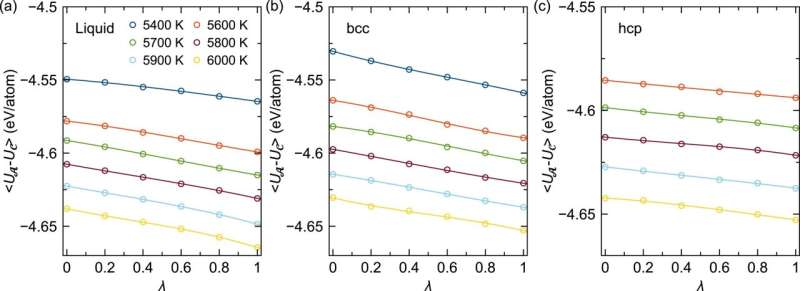This article has been reviewed according to Science X's editorial process and policies. Editors have highlighted the following attributes while ensuring the content's credibility:
fact-checked
peer-reviewed publication
trusted source
proofread
Researchers one step closer to determining iron's structure at the center of Earth

Earth's inner core is dominated by iron, which can exist as a solid material in more than one crystallographic form. (This quality allows iron to combine with other elements to form alloys.) Iron's most stable form at room temperature is the body-centered cubic (bcc) structure. At extremely high pressures, it is stable in its hexagonal close-packed (hcp) phase. Of considerable debate, however, is iron's structure at the center of Earth. In a new study published in Geophysical Research Letters, Yang Sun and colleagues get one step closer to an answer.
The deliberation centers on the melting temperatures of iron's two phases at core pressures: 323 gigapascals at the inner core boundary and 360 gigapascals at the core center. Previous studies have struggled to estimate melting temperatures with any precision. The best guesses have had an uncertainty range of 500 K (440°F).
Researchers use two types of simulations of atomic interaction to estimate iron's melting temperatures at the inner core: classical and ab initio. Both approaches have pros and cons, but neither has yet provided a clear answer. In the new study, scientists bridged the two simulation strategies to calculate the melting temperatures for hcp and bcc iron at Earth's core.
They found that the hcp phase is iron's stable phase at the inner core. The melting temperature of hcp iron is always higher than that of the bcc form, but that difference is very small. At pressures approximating the inner core boundary, the study reports a melting temperature of 6,357 ± 45 K for the hcp phase and 6,168 ± 80 K for the bcc phase. At pressures similar to the core center, the melting temperature was 6,692 ± 45 K for hcp and 6,519 ± 80 K for bcc.
The research offers new perspectives on the structure, evolution, and dynamics of Earth's core. Future work, the scientists say, should include the effect of nickel and light elements in simulations of the inner core's structure.
More information: Yang Sun et al, Ab Initio Melting Temperatures of Bcc and Hcp Iron Under the Earth's Inner Core Condition, Geophysical Research Letters (2023). DOI: 10.1029/2022GL102447
Journal information: Geophysical Research Letters
Provided by American Geophysical Union
This story is republished courtesy of Eos, hosted by the American Geophysical Union. Read the original story here.





















